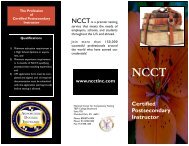P.A.C.E.® Approved COURSE DESCRIPTION - National Center for ...
P.A.C.E.® Approved COURSE DESCRIPTION - National Center for ...
P.A.C.E.® Approved COURSE DESCRIPTION - National Center for ...
You also want an ePaper? Increase the reach of your titles
YUMPU automatically turns print PDFs into web optimized ePapers that Google loves.
Most needle phobic patients have been told that they are “wimps” or “babies” and that<br />
they just need to “grow up and cooperate”. They may be embarrassed about their<br />
condition. There<strong>for</strong>e, healthcare workers should treat these patients with empathy and<br />
respect. A discussion of the prevalence of needle fear, the inherited nature of it, and<br />
methods available to manage it may reassure the patient.<br />
Positioning<br />
Many needle phobics experience a vasovagal reflex reaction (fainting). To prevent this,<br />
patients should lie down with their legs elevated and their heads lowered. This helps<br />
prevent fainting and the symptoms that accompany it. As some needle phobic patients<br />
do not faint until after the procedure, they should be encouraged to remain lying down<br />
or sitting until they feel com<strong>for</strong>table slowly standing up.<br />
Topical Anesthetics<br />
In<strong>for</strong>mation about minimizing procedure pain is growing, as there is increased interest<br />
and awareness among healthcare workers. Due to this, the use of topical anesthetics<br />
prior to IV insertion, injection, and venipuncture is increasing. Topical anesthetics have<br />
two disadvantages: many take a long time to become effective and many only numb the<br />
very top of the skin, allowing deeper needlesticks to be felt.<br />
Be<strong>for</strong>e initiating the use of any topical anesthetic, the literature should be researched<br />
and the manufacturer’s instructions reviewed and followed. In<strong>for</strong>mation on topical<br />
anesthetics follows.<br />
L.M.X.4<strong>®</strong><br />
L.M.X.4<strong>®</strong> is a non-prescription topical cream containing 4% lidocaine.<br />
The 4% strength of lidocaine causes a loss of feeling in the skin and surrounding<br />
tissues. As numbing occurs, a slight cooling sensation may occur.<br />
L.M.X.4<strong>®</strong> is applied at least 30-45 minutes be<strong>for</strong>e the start of the procedure.<br />
The manufacturer provides a clear plastic film to cover the cream after<br />
application to prevent accidental ingestion or removal of the cream.<br />
EMLA<strong>®</strong> (Eutectic Mixture of Local Anesthetics) Cream/Transdermal Patch<br />
EMLA<strong>®</strong> is a prescription cream/transdermal patch containing 2.5% lidocaine and<br />
2.5% prilocaine.<br />
The cream must be covered with a clear plastic film after applied to the skin. The<br />
transdermal patch is simply applied to the skin.<br />
EMLA<strong>®</strong> takes at least 60 minutes to provide numbing sufficient <strong>for</strong> needle<br />
insertion.<br />
Pain Ease<strong>®</strong> Instant Topical Anesthetic<br />
Pain Ease<strong>®</strong> is a skin refrigerant that provides immediate temporary numbing that<br />
lasts up to one minute. It is applied by spraying and it can be reapplied as<br />
needed.<br />
Pain Ease<strong>®</strong> contains pentafluoropropane and tetrafluoroethane.<br />
Page 8 of 19



